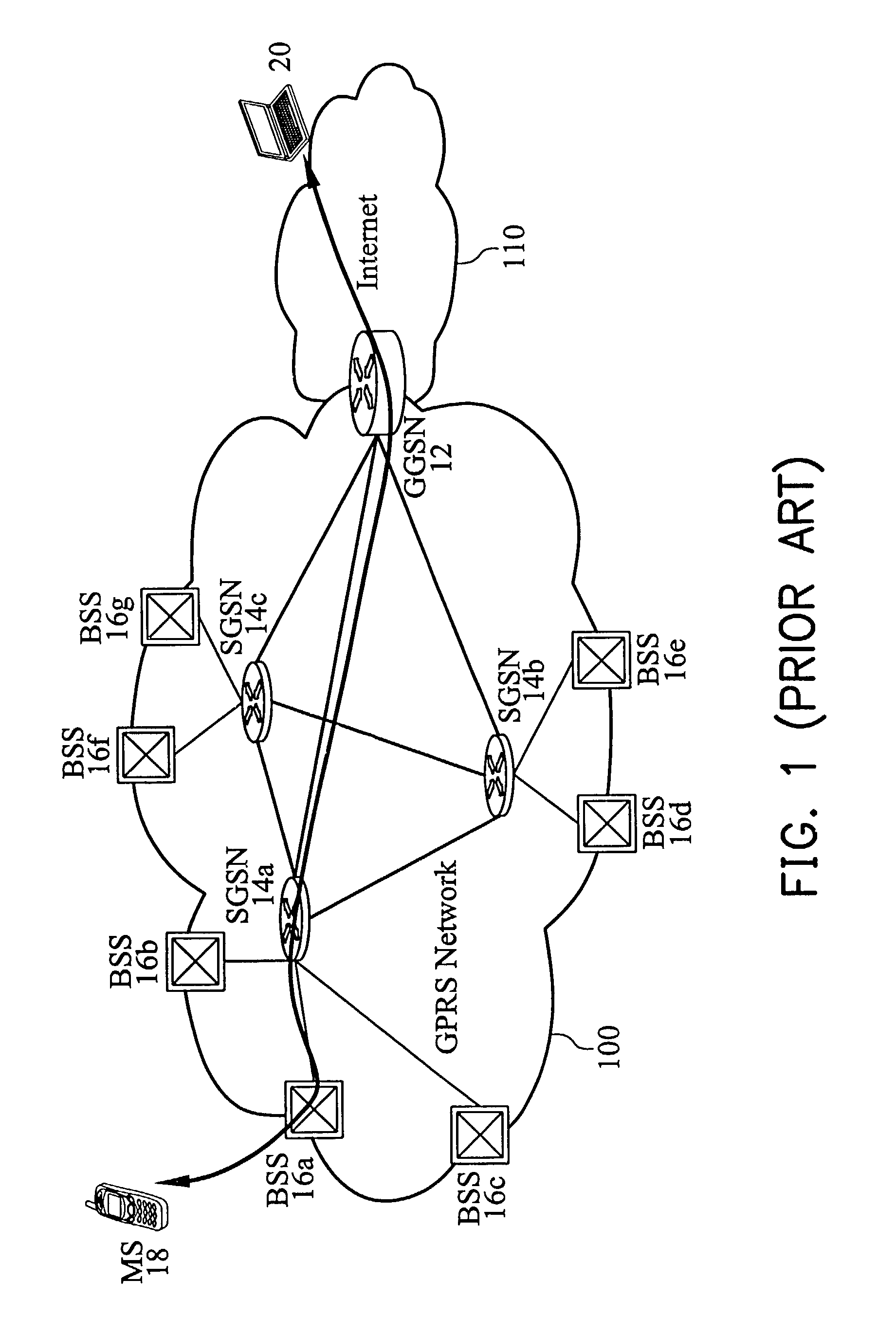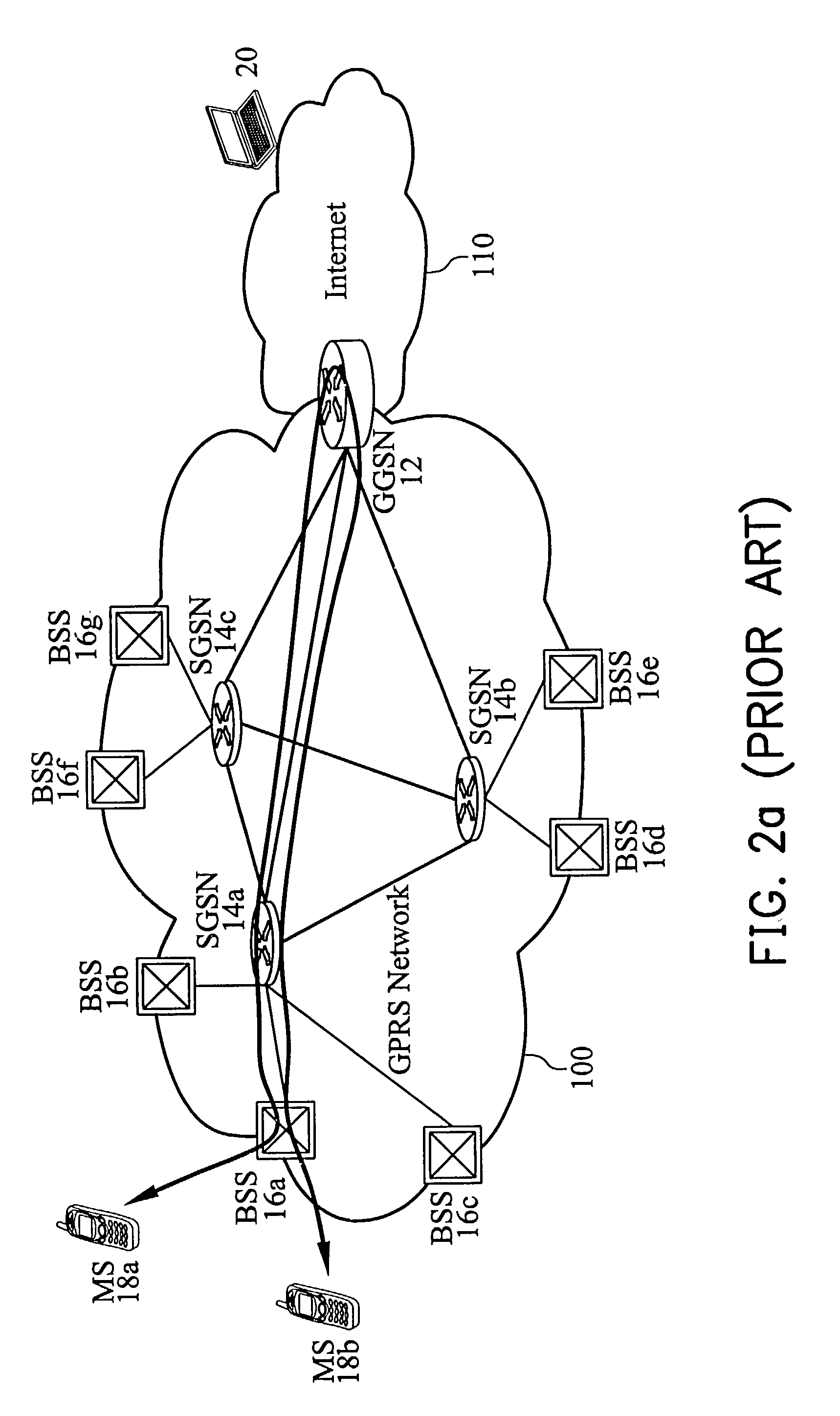Packet delivery method for packet radio networks
a packet radio network and packet technology, applied in the field of routing methods, can solve the problems of path lack efficiency, gprs routing design also lacks efficiency, gprs routing design lacks efficiency, etc., and achieves the effect of reducing end-to-end delay, improving overall performance of packet radio networks, and efficient delivery
- Summary
- Abstract
- Description
- Claims
- Application Information
AI Technical Summary
Benefits of technology
Problems solved by technology
Method used
Image
Examples
first embodiment
[0029]FIG. 3 is an inventive MS-to-MS communication when MSs are in different SGSNs based on the typical GPRS network. In FIG. 3, the General Packet Radio Service (GPRS) network 200 includes Gateway GPRS Support Node (GGSN) 32, Serving GPRS Support Nodes (SGSNs) 34a˜34c, base station subsystems (BSSs) 36a˜36gand mobile stations (MSs) 38a˜38b, wherein GGSN 32 is an interface between an external network, for example the Internet 210, and the network 200. The external network can be a TCP / IP or X.25 network. Thus, MSs in the GPRS network 200 can communicate with a host 30 on the Internet 210.
[0030]As shown in FIG. 3, MS 38a connects to the network 200 through BSS 36a and is serviced by SGSN 34a. MS 38b connects to the network 200 through BSS 36d and is serviced by SGSN 34b. After an initiation between MSs 38a and 38b is completed (see FIG. 4a), a bidirectional communication between MSs 38a and 38b is established. When MS 38a has a packet to MS 38b, MS 18a forwards the packet to SGSN 34...
second embodiment
[0056]FIG. 7 is an MS-to-MS communication according to the invention. As shown in FIG. 7, the network 200 is the same as that in FIG. 3 except that MS 38a connects to the network 200 through BSS 36a, MS 38b connects to the network 200 through BSS 36c, and both MSs 38a and 38b are serviced by SGSN 34a. After initiation between MSs 38a and 38b is complete by method of GGSN 32 (the same procedures as FIG. 4a but replacement of SGSN 34b with SGSN 34a), MSs 38a and 38b can communicate with one another. When MS 38a has data packets to MS 38b, MS 38a first sends data packets to SGSN 34a through BSS 36a and then SGSN 34a directly forwards the packets to MS 38b through BSS 36c because of the same servicing SGSN. Also, when MS 38b has data packets to MS 38a, MS 38b first sends data packets to SGSN 34a through BSS 36c and then SGSN 34a directly forwards the packets to MS 38a through BSS 36a because of the same servicing SGSN. Thus, such a data packet delivery method applied to GPRS networks is...
third embodiment
[0059]FIG. 8 is an MS-to-MS communication according to the invention. As shown in FIG. 8, the network 200 is the same as in FIG. 3 except that MSs 38a and 38b connect to the network 200 through BSS 36a and are serviced by SGSN 34a. After initiation between MSs 38a and 38b is complete by method of GGSN 32 (the same procedures as FIG. 4a but replacing SGSN 34b with SGSN 34a), MSs 38a and 38b can communicate with one another. When MS 38a has data packets to MS 38b, MS 38a first sends data packets to SGSN 34a through BSS 36a and then SGSN 34a directly forwards the packets to MS 38b through BSS 36a because of the same servicing SGSN. Also, when MS 38b has data packets to MS 38a, MS 38b first sends data packets to SGSN 34a through BSS 36a and then SGSN 34a directly forwards the packets to MS 38a through BSS 36a because of the same servicing SGSN. Thus, this data packet delivery method applied to GPRS networks is more effective than in FIG. 2a.
[0060]It is noted that in this embodiment, a ...
PUM
 Login to View More
Login to View More Abstract
Description
Claims
Application Information
 Login to View More
Login to View More - R&D
- Intellectual Property
- Life Sciences
- Materials
- Tech Scout
- Unparalleled Data Quality
- Higher Quality Content
- 60% Fewer Hallucinations
Browse by: Latest US Patents, China's latest patents, Technical Efficacy Thesaurus, Application Domain, Technology Topic, Popular Technical Reports.
© 2025 PatSnap. All rights reserved.Legal|Privacy policy|Modern Slavery Act Transparency Statement|Sitemap|About US| Contact US: help@patsnap.com



